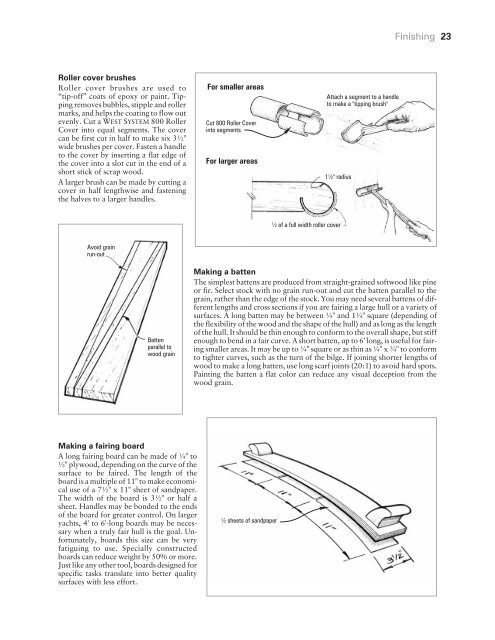Final Fairing & Finishing - WEST SYSTEM Epoxy
Final Fairing & Finishing - WEST SYSTEM Epoxy
Final Fairing & Finishing - WEST SYSTEM Epoxy
Create successful ePaper yourself
Turn your PDF publications into a flip-book with our unique Google optimized e-Paper software.
Roller cover brushes<br />
Roller cover brushes are used to<br />
“tip-off” coats of epoxy or paint. Tipping<br />
removes bubbles, stipple and roller<br />
marks, and helps the coating to flow out<br />
evenly. Cut a <strong>WEST</strong> <strong>SYSTEM</strong> 800 Roller<br />
Cover into equal segments. The cover<br />
can be first cut in half to make six 3½"<br />
wide brushes per cover. Fasten a handle<br />
to the cover by inserting a flat edge of<br />
the cover into a slot cut in the end of a<br />
short stick of scrap wood.<br />
A larger brush can be made by cutting a<br />
cover in half lengthwise and fastening<br />
the halves to a larger handles.<br />
Avoid grain<br />
run-out<br />
Batten<br />
parallel to<br />
wood grain<br />
Making a fairing board<br />
A long fairing board can be made of ¼" to<br />
½" plywood, depending on the curve of the<br />
surface to be faired. The length of the<br />
board is a multiple of 11" to make economical<br />
use of a 7½" x 11" sheet of sandpaper.<br />
The width of the board is 3½" or half a<br />
sheet. Handles may be bonded to the ends<br />
of the board for greater control. On larger<br />
yachts, 4' to 6'-long boards may be necessary<br />
when a truly fair hull is the goal. Unfortunately,<br />
boards this size can be very<br />
fatiguing to use. Specially constructed<br />
boards can reduce weight by 50% or more.<br />
Just like any other tool, boards designed for<br />
specific tasks translate into better quality<br />
surfaces with less effort.<br />
For smaller areas<br />
Cut 800 Roller Cover<br />
into segments<br />
For larger areas<br />
<strong>Finishing</strong> 23<br />
Making a batten<br />
The simplest battens are produced from straight-grained softwood like pine<br />
or fir. Select stock with no grain run-out and cut the batten parallel to the<br />
grain, rather than the edge of the stock. You may need several battens of different<br />
lengths and cross sections if you are fairing a large hull or a variety of<br />
surfaces. A long batten may be between ¾" and 1¼" square (depending of<br />
the flexibility of the wood and the shape of the hull) and as long as the length<br />
of the hull. It should be thin enough to conform to the overall shape, but stiff<br />
enough to bend in a fair curve. A short batten, up to 6' long, is useful for fairing<br />
smaller areas. It may be up to ¾" square or as thin as ¼" x ¾" to conform<br />
to tighter curves, such as the turn of the bilge. If joining shorter lengths of<br />
wood to make a long batten, use long scarf joints (20:1) to avoid hard spots.<br />
Painting the batten a flat color can reduce any visual deception from the<br />
wood grain.<br />
½ sheets of sandpaper<br />
½ of a full width roller cover<br />
Attach a segment to a handle<br />
to make a "tipping brush"<br />
1½" radius
















